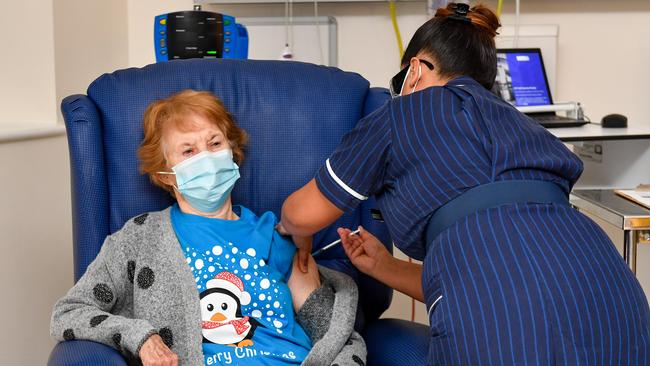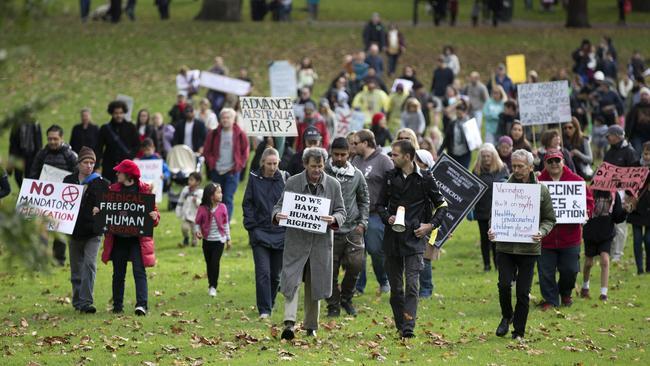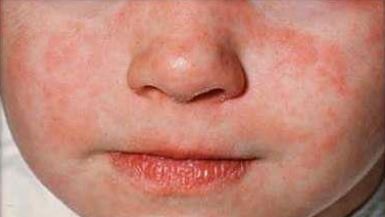
On Tuesday, 90-year-old UK grandmother Margaret Keenan became the first patient outside a clinical trial to receive the COVID-19 vaccine developed by US based pharmaceutical company, Pfizer and its German partner, BioNTech.

Later that day, an 81-year-old with the impressive name of William Shakespeare received the first of his two jabs. Enter stage left a million puns in the media which amounted to much ado about nothing. Sorry.
A thousand puns in the comments. "The taming of the flu," is my favorite https://t.co/Mk8M0iRQdp
— Austin Ramzy (@austinramzy) December 8, 2020
If we believe those at the delusional end of the anti-vaccination movement, Bill Gates is now operating both Keenan and Shakespeare by a complex system of pulleys and levers. The pair and others who have had their first COVID-19 jabs (two are required per person 14 days apart) may stumble off at any time to download Microsoft Teams which if my experience is anything to go by, is the real crime here.
The founder of Microsoft is one of the targets for the anti-vaccination movement because the Gates Foundation spends a lot of money inoculating children and adults around the world from preventable diseases. The usual paranoid gibbering accuses Gates and others, including Big Pharma and the deep state, of a raft of crimes including mind control and increasing rates of Autism Spectrum Disorder, all of which have no basis in fact. None.
The Americans have a saying that anti-vaxxers are more likely to drive a Prius than a pick-up. Anti-vaxxers are almost always educated and middle class. It is easy to say these are people with a functioning internet connection and too much time on their hands. While this is often true, there are a great many people who want to do the right thing but are being influenced by misinformation.
Looking at the community, we know around 80 per cent of Australians are persuaded by the benefits of vaccination. They get it. Then there’s a smaller group who are anti-vax dogmatists. They have drunk the Kool Aid. They are for the most part, too far gone down the hippy, alternative medicine trail to come back. Then there are others who have legitimate questions and doubts. Unfortunately, medical science and public health officials are losing the battle to win them over.
The best way to understand the anti-vaccination movement is that it’s packed with grifters and hucksters who make money based on people’s fears by flogging alternatives to medical science.

The anti-vaccination movement is large and amorphous, driven essentially by social media. In a peer reviewed report published in Lancet in October, The Centre for Controlling Digital Hate quantified the extent of support for the anti-vaccination movement. The report found 31 million people followed anti-vaccination groups on Facebook with 17 million people doing likewise on YouTube.
Monetising this support through targeted advertising, the CCDH estimated revenues to Facebook, and Instagram somewhere around $AUD 1.5 billion.
It is true that Facebook and other social media have deplatformed many anti-vaccination groups recently. Depending on who you listen to, this is either a step in the right direction or too little too late. Deplatforming anti-vax groups is a kind of Whack-A-Mole exercise. Pushing them out often means they pop up elsewhere on other platforms and continue on their merry way.
With the exception of Margaret Keenan, William Shakespeare and a handful of others, a COVID-19 vaccine exists in the esoteric. So let’s move away from it for a moment and look at another disease that broad inoculation programs should have eradicated by now.
Here we see the grifters who profit from anti-vaccination fears have created a public health nightmare which shows no signs of abating.
It is also an example that public health officials should be singing from the rooftops.
Measles is an especially virulent infection. We worry about COVID-19 and methods of transmission and we should of course. The Sars-CoV-2 virus remains airborne for three to five metres in most situations before it dies without a host. Measles is one of the most contagious diseases known to medical science. A child sitting at one end of the MCG could fall prey to it with an infectious person sitting at the other end of the ground. The virus can remain airborne for up to 300 metres.

The first sign of measles is usually a high fever, which begins about 10 to 12 days after exposure to the virus. The fever endures for between four and seven days. During this time, other symptoms emerge including a runny nose, a cough, red and watery eyes, and small white spots inside the cheeks. A few days later, a rash erupts, usually on the face and upper neck. The rash spreads covering the body to the extremities and this generally lasts for a week before fading.
Those with measles remain infectious from exposure onwards, a period of up to 30 days.
Children five years of age or under are most vulnerable to measles-related deaths. The most serious complications of measles infection include blindness, encephalitis (an infection that causes brain swelling), severe diarrhoea and related dehydration, ear infections, or severe respiratory infections such as pneumonia.
It would be difficult to imagine a more painful death for infants.
Measles infections have increased across the world by 50 per cent since 2016. Last year, 208,000 people, mainly children, died from measles-related complications. Those deaths were all preventable.
The two stage measles inoculation was introduced in Australia in 1992. Children generally receive a jab at 12 months of age and another six months later, all free of charge under the National Immunisation Program.
Prior to inoculation we had around 5000 cases per million people. Ten years later, it was reduced to two cases per million. And technically that should have been eradication.
But by 2014, we were back up to 365 cases per million. While that year was a peak, cases are trending upwards again. All on the back of the anti-vaccination movement.
And we know this because the instances of infection have occurred in inner cities and some of our, shall we say, hippy infested regional towns. Byron Bay is a hot spot. Brunswick in Melbourne another one.
The point of any vaccine is to create a herd immunity. The question is, will enough Australians stand in line for their COVID-19 jabs to make this happen? We are at a crucial time, a time where fear is being monetised while facts are too easily ignored.








As Covid vaccines are rolled out around the world, the anti-vaccination movement is about to make big, scary noises that can render immunisation programs useless.